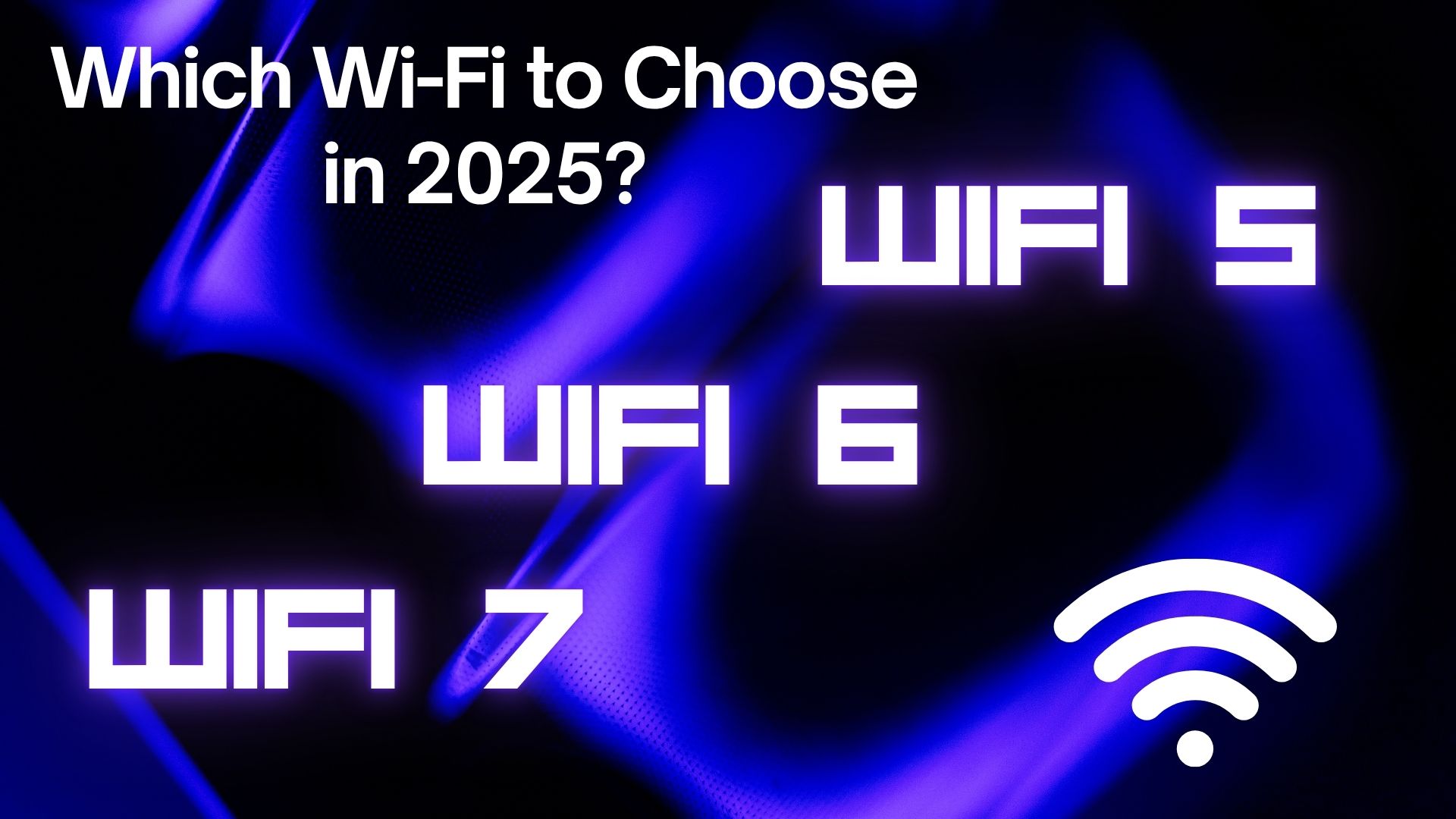
Which Wi-Fi Router to Choose in 2025 – Wi-Fi 5 vs Wi-Fi 7 Comparison
🧠 Introduction: Why Choosing the Right Router Matters
Whether you’re setting up Wi-Fi at home, in an office, or running a business, the quality of your wireless connection determines how smoothly everything works — from video calls to cloud storage and IoT devices.
But with so many routers on the market and new standards like Wi-Fi 7, it’s not always clear which option is best. Should you save money with an older Wi-Fi 5 router, choose a reliable Wi-Fi 6 model, or go all-in on Wi-Fi 7?
Let’s explore what makes each generation different and compare router types, so you can make a smart, future-proof decision.
📶 Understanding Wi-Fi Generations
Each new generation of Wi-Fi brings improvements in speed, efficiency, and stability — especially when multiple devices are connected at the same time. Here’s how they compare:
🔹 Wi-Fi 5 (802.11ac)
Wi-Fi 5, introduced around 2013, revolutionized home and office connectivity. It uses the 5 GHz band to deliver speeds up to 3.5 Gbps under ideal conditions.
✅ Pros:
- Still widely available and affordable
- Good for streaming, browsing, and light gaming
- Mature technology with stable firmware
❌ Cons:
- Struggles with many connected devices
- No multi-link operation or advanced power management
- Limited efficiency in busy environments
Best for: Homes or small offices with up to 15–20 connected devices.
🔹 Wi-Fi 6 / Wi-Fi 6E (802.11ax)
Wi-Fi 6 is the modern workhorse of wireless technology. It focuses not only on speed (up to 9.6 Gbps) but also on efficiency and capacity.
✅ Pros:
- Handles many devices simultaneously using OFDMA and MU-MIMO
- Reduces latency (great for online meetings and gaming)
- Better security with WPA3
- Wi-Fi 6E adds access to the 6 GHz band for less interference
❌ Cons:
- Slightly higher cost
- Older devices may not fully benefit
Best for: Homes, cafés, or offices where multiple users and devices connect daily.
🔹 Wi-Fi 7 (802.11be)
Wi-Fi 7 is the newest and most powerful standard, released in 2024–2025. It offers theoretical speeds up to 46 Gbps and introduces Multi-Link Operation (MLO), allowing devices to use multiple frequencies at once.
✅ Pros:
- Ultra-fast and ultra-stable connections
- Massive bandwidth for 8K video, AR/VR, and smart offices
- Extremely low latency for real-time tasks
- Designed for dense, high-performance networks
❌ Cons:
- Expensive hardware (still early on the market)
- Few devices fully support Wi-Fi 7 yet
Best for: Tech-forward businesses, gaming centers, or environments with hundreds of connected devices.
⚙️ Comparison Table: Wi-Fi 5 vs Wi-Fi 6 vs Wi-Fi 7
| Feature | Wi-Fi 5 | Wi-Fi 6 / 6E | Wi-Fi 7 |
|---|---|---|---|
| Max Speed | ~3.5 Gbps | ~9.6 Gbps | ~46 Gbps |
| Frequency Bands | 5 GHz | 2.4, 5, and 6 GHz (6E) | 2.4, 5, and 6 GHz |
| Channel Width | 80 / 160 MHz | 160 MHz | 320 MHz |
| Device Handling | Good | Excellent | Outstanding |
| Latency | Medium | Low | Ultra-low |
| Security | WPA2 | WPA3 | WPA3 Enhanced |
| Cost | Low | Moderate | High |
| Ideal For | Home, small offices | Businesses, remote work | Heavy traffic, future networks |
🧩 Router Types: From Home Models to Business-Grade Solutions
When it comes to hardware, routers differ not just in performance but in how they’re managed and how scalable they are.
🏠 Consumer Routers (Wi-Fi 5/6)
- Examples: TP-Link Archer, ASUS RT Series, Netgear Nighthawk
- Pros: Easy setup, affordable, good coverage for small areas
- Cons: Manual configuration, limited control, weaker security management
- Ideal for: Homes or small offices with fewer users
🏢 Business Routers / Access Points
- Examples: Aruba Instant On, Ubiquiti UniFi, Cisco Business
- Pros:
- Cloud management and monitoring
- Automatic updates and advanced security
- Seamless scalability with multiple access points
- Cons: Slightly higher cost, requires initial setup
- Ideal for: Businesses, co-working spaces, schools, and retail networks
💡 Aruba Instant On is especially popular because it combines enterprise-grade reliability with plug-and-play simplicity, all managed from a free mobile app.
🚀 Wi-Fi 7 Routers (Next-Gen)
- Examples: TP-Link BE900, ASUS RT-BE96U, Netgear Nighthawk RS700S
- Pros: Unmatched performance, ready for future applications
- Cons: High cost, still early adoption stage
- Ideal for: Power users, tech companies, or anyone preparing for next-gen connectivity
💬 Real-World Scenarios: Which to Choose?
| Environment | Recommended Standard | Example |
|---|---|---|
| Small home or apartment | Wi-Fi 5 | TP-Link Archer A7 |
| Small business or café | Wi-Fi 6 | Aruba Instant On AP22 |
| Large office / modern enterprise | Wi-Fi 6E or Wi-Fi 7 | Aruba AP32 or ASUS RT-BE96U |
| Tech lab / gaming zone | Wi-Fi 7 | Netgear RS700S |
🔚 Conclusion: What’s the Smart Choice?
If you want stability, affordability, and reliability, Wi-Fi 6 routers or access points (like Aruba Instant On) strike the perfect balance.
They’re future-ready, handle many devices, and are secure enough for modern business environments.
Wi-Fi 7 is the future — and it’s incredible — but unless you have ultra-demanding workloads or need top-end speeds today, Wi-Fi 6 will cover your needs for years to come.
In short:
- Wi-Fi 5 — Budget-friendly and simple.
- Wi-Fi 6 / 6E — The best all-rounder for most users.
- Wi-Fi 7 — The premium, next-generation experience.
❓ FAQ
Q1: Is Wi-Fi 7 worth it right now?
Only if you need maximum speed and ultra-low latency. For most users, Wi-Fi 6 offers excellent performance at a lower cost.
Q2: What’s the biggest difference between Wi-Fi 6 and Wi-Fi 7?
Wi-Fi 7 doubles channel width (up to 320 MHz) and adds Multi-Link Operation, which drastically increases speed and stability.
Q3: Can I use a Wi-Fi 7 router with Wi-Fi 6 devices?
Yes. Wi-Fi 7 routers are backward compatible with older devices — they’ll just work at the lower device speed.
Q4: Is Aruba Instant On good for small businesses?
Absolutely. It provides enterprise-level reliability and cloud control with a user-friendly setup — perfect for cafés, offices, and shops.
Q5: How can I improve my existing Wi-Fi without buying a new router?
Try repositioning your router, using mesh extenders, and ensuring your firmware is up to date.
If you’re planning to upgrade your wireless network or need help choosing the right router, you can buy and configure professional Wi-Fi equipment directly from Comstex.
Our experts will help you select, install, and optimize the best Aruba Instant On or Wi-Fi 7 solution for your business.

ADDING POWERSHELL SNAP-IN FOR MICROSOFT EXCHANGE 2019 2016 2013
How to add PSSnapin to execute Exchange PowerShell commands? Prerequisites: Can be executed on Exchange Server...
Read More
Omnissa Horizon vs Inuvika OVD — VDI Alternative 2025
For years, Omnissa Horizon (formerly VMware Horizon) has been the established leader in the VDI...
Read More
Cybersecurity in 2025: Protecting Your Business Starts Now
Why 2025 raises the bar Remote and hybrid work, AI-powered attacks, and tighter regulations mean...
Read More
How to Choose Network Equipment for Your Business: Cisco vs. HPE Aruba vs. Dell vs. Sophos
Modern networks carry everything—voice, video, SaaS, cameras, POS—and downtime isn’t an option. In this guide,...
Read More

